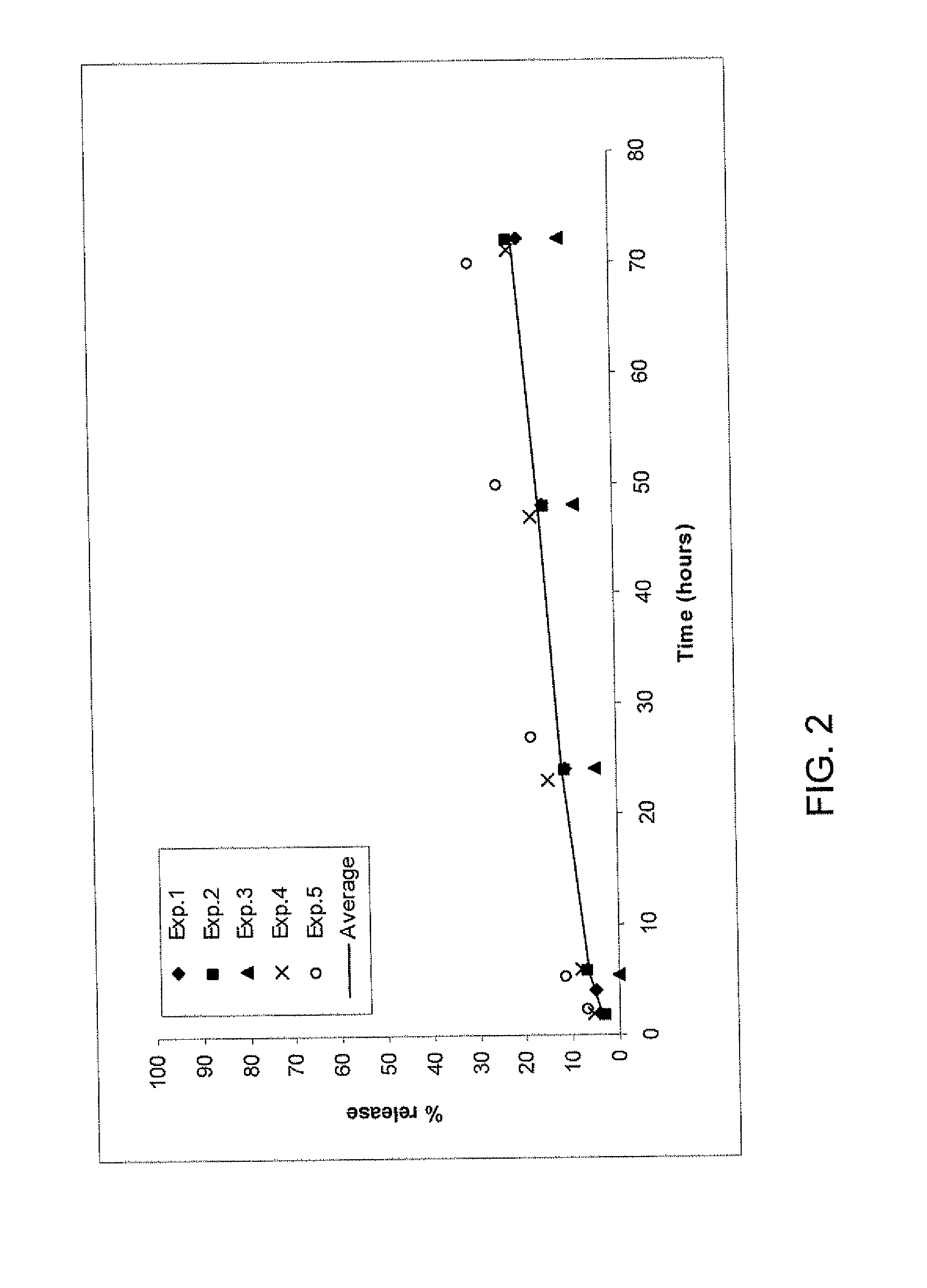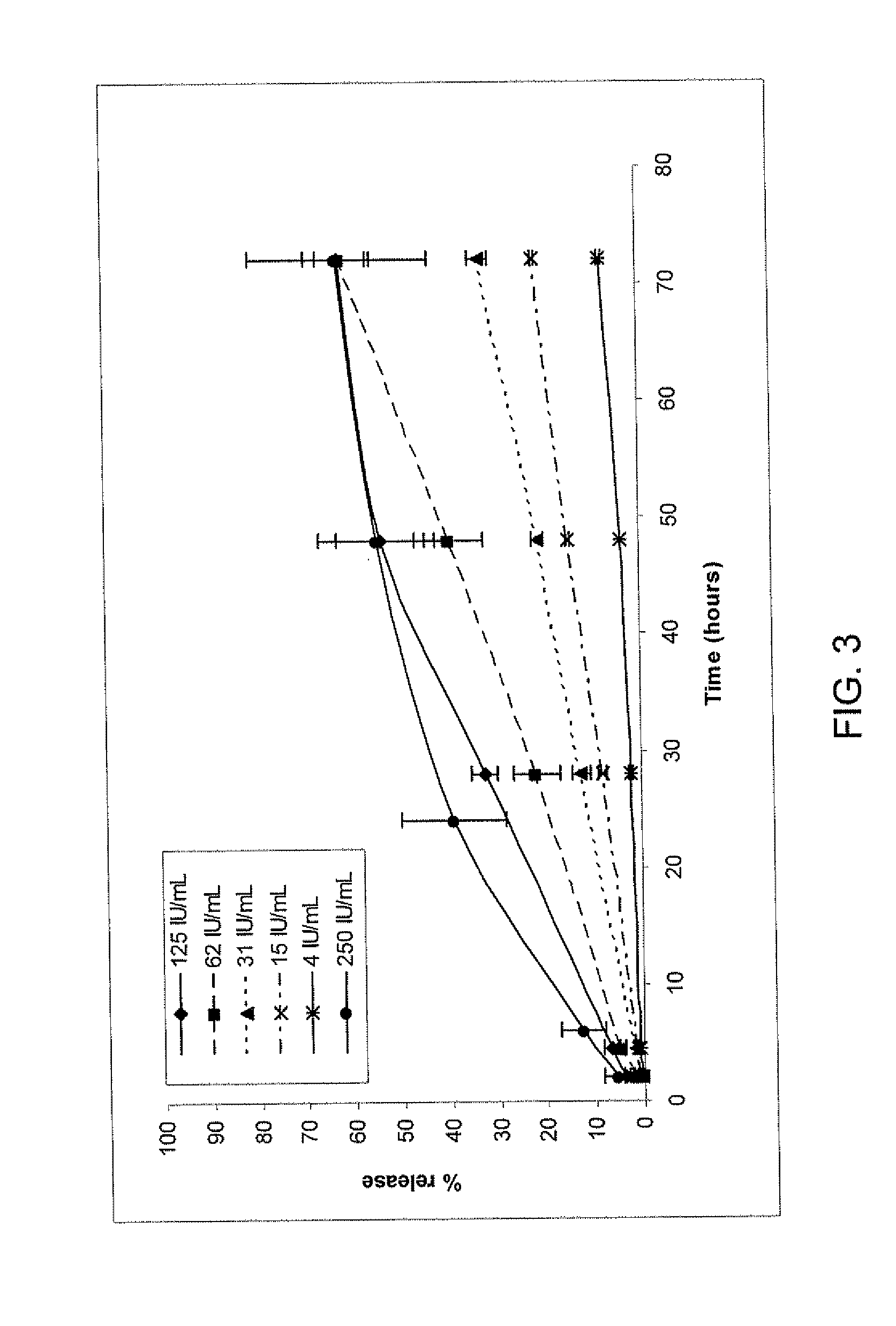Fibrin Formulations for Wound Healing
a fibrin gel and composition technology, applied in the field of fibrin compositions and fibrin formulations, can solve the problems of high amount of growth factor released from fibrin gel, inability to protect patients from adverse reactions to non-autologous components, etc., and achieve the effect of promoting cell proliferation or in-growth, reducing the size of chronic wounds
- Summary
- Abstract
- Description
- Claims
- Application Information
AI Technical Summary
Benefits of technology
Problems solved by technology
Method used
Image
Examples
example 1
Release Rates of Two Different Concentrations of TG-PDGF.AB from a Fibrin Matrix
[0175]A release study using the fibrin formulations as described in the release study protocol was done 5 times (with the same or different lots, on different days) with fibrinogen solution containing either 66 or 600 μg TG-PDGF.AB / ml fibrinogen precursor solution. An average release rate was calculated using these 5 experiments.
[0176]The release rate of the higher dose (600 μg TG-PDGF.AB / ml fibrinogen precursor solution) (FIG. 1) is higher than the release rate of the lower dose (66 μg TG-PDGF.AB / ml fibrinogen precursor solution) (FIG. 2) over 70 hours: 62% and 21% respectively of the initial PDGF amount is released within 70 hours, which indicates that the chemical binding is not as efficient with higher concentrations of TGPDGF than with lower concentrations.
example 2
Influence of Thrombin Concentration on the Release of TG-PDGF.AB
[0177]A release study was performed using different amounts of thrombin (4, 15, 31, 62, 125 and 250 IU thrombin / mi thrombin precursor solution (equivalent to 0.08, 0.3, 0.62, 2.5 and 5 I.U. thrombin / mg fibrinogen)), the fibrinogen solution remaining unchanged (50 mg fibrinogen / ml fibrinogen precursor solution (equivalent to 25 mg fibrinogen / ml fibrin formulation) and 600 μg TG-PDGF.AB / ml fibrinogen precursor solution (12 μg TG-PDGF.AB / mg fibrinogen (see FIGS. 3) and 66 μg TG-PDGF.AB / ml fibrinogen precursor solution (equivalent to 1.32 μg TG-PDGF.AB / ml fibrinogen (FIG. 4).
[0178]Data corresponding to 250 IU thrombin / ml thrombin precursor solution and 4 IU thrombin / ml thrombin precursor solution of FIGS. 3 and 4 are presented are shown in FIG. 5. For both doses, decreasing the thrombin concentration leads to a lower release rate.
example 3
Release Study with Differing Amounts of Factor XIII
[0179]A release study was performed adding different amounts of factor XIII in the fibrinogen solution (0, 0.2, 2 and 20 I.U. factor XIII / ml fibrinogen precursor solution i.e. 0, 0.1, 1 and 10 I.U. factor XIII / ml fibrin formulation). The fibrinogen concentration for all samples was 50 mg fibrinogen / ml of fibrinogen precursor solution.
[0180]This experiment was done for the higher (300 μg TG-PDGF.AB / ml fibrin formulation (equivalent to 6 μg TG-PDGF.AB / mg fibrinogen) and lower concentrations (33 μg TG-PDGF.AB / ml fibrin formulation (equivalent to 0.66 μg TG-PDGF.AB / mg fibrinogen) using 250 IU thrombin / ml thrombin precursor solution (equivalent to 5 I.U. thrombin / mg fibrinogen) (FIGS. 6 and 7 respectively), and for the higher and lower doses using 4 IU thrombin / ml thrombin precursor solution (equivalent to 0.08 I.U. thrombin / mg fibrinogen) (FIGS. 8 and 9 respectively).
[0181]For 250 IU thrombin / ml thrombin precursor solution, increasing f...
PUM
| Property | Measurement | Unit |
|---|---|---|
| concentration | aaaaa | aaaaa |
| concentration | aaaaa | aaaaa |
| concentration | aaaaa | aaaaa |
Abstract
Description
Claims
Application Information
 Login to View More
Login to View More - R&D
- Intellectual Property
- Life Sciences
- Materials
- Tech Scout
- Unparalleled Data Quality
- Higher Quality Content
- 60% Fewer Hallucinations
Browse by: Latest US Patents, China's latest patents, Technical Efficacy Thesaurus, Application Domain, Technology Topic, Popular Technical Reports.
© 2025 PatSnap. All rights reserved.Legal|Privacy policy|Modern Slavery Act Transparency Statement|Sitemap|About US| Contact US: help@patsnap.com



